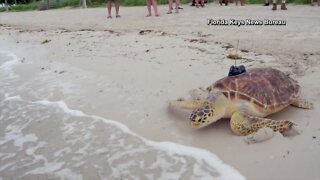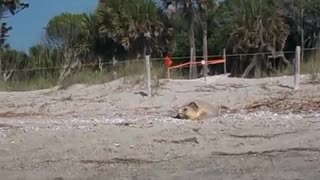Premium Only Content

Crippled Sea Turtle gets released back into the ocean
This juvenile Green Sea Turtle was found at the beach and had to be rescued and rehabilitated. It is missing a flipper, but Green Turtles are very resilient, and with a lot of care from biologists and veterinarians, it was able to be returned to the ocean, as it can still swim, but because it has difficulty walking on the sand, it had to be released directly into the ocean, where it can swim just fine, in spite of the missing member. What a lovely happy ending!
The Green Turtle is one of the seven species of sea turtles recognized today, along with the Loggerhead, the Hawksbill, the Leatherback, the Olive Ridley, the Kemp's Ridley and the Flatback. An 8th species has been suggested, the Black Sea Turtle, which presents a dark color and domed carapace, as well as smaller adult size than the Green Turtle, and extreme caudal dimorphism, but it is still consider too genetically similar to the Green Turtle to be considered a separate species; it is more accepted as a subspecies, and sometimes even just a different population.
Contrary to popular belief, the Green Turtle is not named after its color, but for the green coloration of its fat. Their carapace color actually varies from pale to very dark green, plain to brilliant yellow, or even brown and green with radiating stripes. The plastron varies from white to yellowish in the Atlantic Ocean, and from dark grey to bluish-green in the Pacific Ocean. The hatchlings are dark-brown above with white underneath and on the margins of the flippers.
They are the only species of sea turtle that are strictly herbivorous as adults, and eat mostly sea grass and algae once they reach 8 to 10 inches in length.
-
 1:03
1:03
NataliaCara
2 years agoBeing a foster mom to monkeys and anteaters is... an interesting job...
3161 -
 1:01
1:01
NataliaCara
5 years agoHeroic biologist helps a crippled sea turtle dig her nest
4.89K10 -
 0:46
0:46
WPTV
5 years agoRare sea turtle released into the ocean
1871 -
 2:39
2:39
TriangleRailProductions
4 years ago $0.07 earnedTurtle Crawls into Ocean in broad daylight
2001 -
 0:03
0:03
nelsonkadennn
4 years ago $0.02 earnedOcean Turtle
118 -
 1:00:08
1:00:08
The Officer Tatum
4 hours agoLIVE: Left CANCELS Their Own, All White Town, NYC Shooter Update + MORE | EP 146
21.1K16 -
 LIVE
LIVE
The Rabble Wrangler
15 hours agoRimWorld with The Best in the West!
65 watching -
 LIVE
LIVE
MissesMaam
5 hours agoVariety Stream💚✨
80 watching -
 LIVE
LIVE
blackfox87
1 hour agoHot Droppin! | PREMIUM CREATOR | #DisabledVeteran
55 watching -
 1:23:27
1:23:27
Redacted News
3 hours agoBREAKING! FBI DIRECTOR DROPS BOMBSHELL, REVEALS HIDDEN 'BURN BAGS' AND MISSING EPSTEIN FOOTAGE
128K138